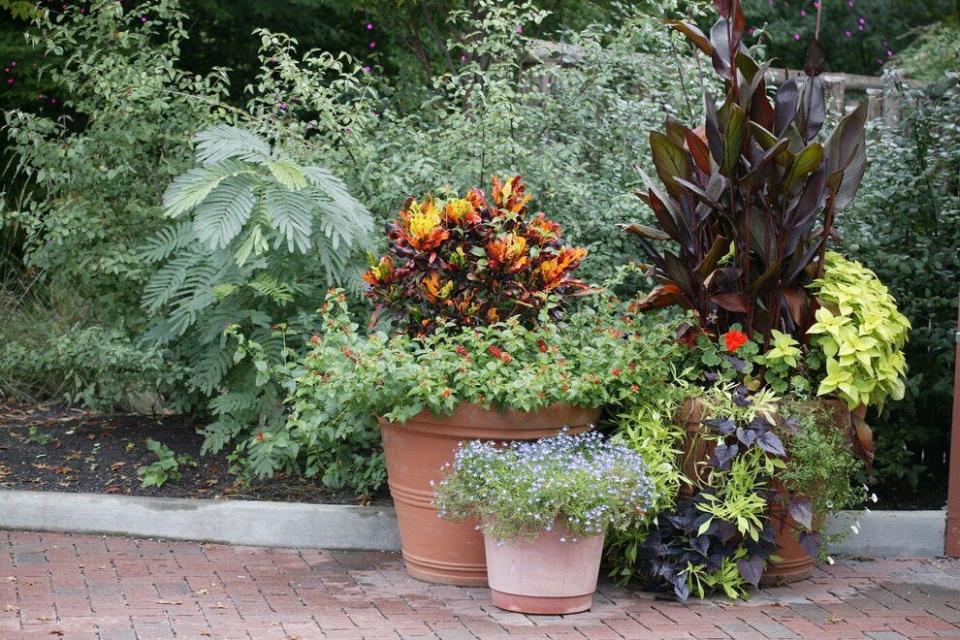Want to garden, but don't have much space? Here's how to start a container garden.
Vegetable gardening is in full swing but you don’t have to have lots of land to successfully grow vegetables. Just a back patio or small porch will do just fine.
For homeowners who want to grow vegetables but have limited space, container gardening may be the answer. It is quite common to see annuals, perennials and even ornamental grasses grown in containers, but the idea of vegetables is foreign for some.
But why shouldn’t we pot up peppers and tomatoes? They are colorful, they can be placed on decks and patios where gardens could not normally exist and you can eat them or parts of them at least.
There are of course a few guidelines to follow when you start vegetable container gardening.
Selection of a container should be based on the weight, cost and how often you are willing to water. These are all related concerns since the bigger the container the more it will weigh and cost but the less you will have to water.
Not all containers have to be expensive. Even a five-gallon bucket with holes drilled in the bottom will be sufficient for a pepper plant and a two-inch-deep baking pan can be used for lettuce or chard. Vegetables do require a minimum root zone to produce.

The list of vegetables further down will describe how much is needed for certain plants. Do remember that all containers need drainage holes.
Bags of potting mix or soilless mix is preferred over garden soil, since native soil likely will contain a large percentage of clay which dries out quickly and hardens. Native soil also contains more weed seeds than potting mixes.
When filling your container, place a piece of landscape fabric over the holes to retain the soil but allow the water to drain.
Mix a timed-release fertilizer into your soil mix as you add it to the container. Some potting mixes have fertilizer already mixed in. Throughout the season you will need to fertilize with a soluble fertilizer to keep your vegetables performing well.
Water is the most important concern to container gardening. Containers placed on concrete slabs in full sun will dry out quickly. You may need to water every day.
Using plant stands that allow for airflow between the container and concrete surface can reduce the drying heat. If a plant becomes too dry, small feeder roots are destroyed and plants will wilt.
After watering, the plant has to spend more time making new feeder roots which means less time is put into vegetable production and fruits may be stunted. Using a light mulch of pine straw or shredded bark on the container surface can also reduce moisture problems.
Many vegetables grown in gardens may also be grown in containers. The limiting factor is growing space. The list below is not a complete list but should give you some idea when pairing vegetables to container size.
Beans, Lima (Bush Baby, Bush Lima, Fordhook) – 12 inches wide by 8 inches deep
Beans, Snap (Tendercrop, Blue Lake, Stringless) – 8 inches wide by 8 inches deep
Cabbage (Baby Head, Dwarf Morden, Fast Ball) – 10 inches wide by 12 inches deep
Carrots (Gold Nugget, Thumbelina, Baby Spike) – 10 inches wide by 10 inches deep
Corn (Golden Bantam, Kandy Korn) - 21 inches wide by 8 inches deep (3 plants to container)
Cucumber (Pickalot, Burpee Hybrid II, Spacemaster) -20 inches wide by 16 inches deep
Lettuce (Salad Bowl, Tom Thumb, Little Gem) - 8 inches wide by 8 inches deep
Peas (Little Marvel, Sugar Mel, Sugar Rae) - 12 inches deep
Peppers (any variety) – 16 inches deep
Summer Squash (Crookneck, Peter Pan, Straightneck) – 24 inches deep
Tomatoes (Patio VF, Pixie, Yellow Pear, Rutgers, Tiny Tim, Red Cherry) – Dwarf 12 inches deep; Standard 24 inches deep
Growing vegetables right outside your backdoor is easy and not expensive. The ability to harvest fresh vegetables throughout the summer is the best benefit.
P. Andrew Rideout is the UK Extension Agent for Horticulture and can be reached at pandrewrideout@uky.edu.
This article originally appeared on Evansville Courier & Press: Want to garden, but don't have much space? Try a container garden.

